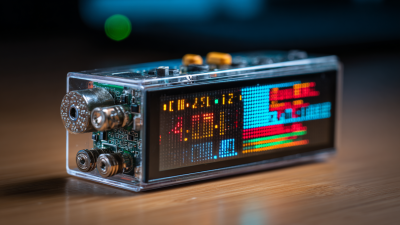Choosing the right Oled Touch Monitor for your business needs can significantly impact your efficiency and productivity. With the rapid advancements in display technology, Oled Touch Monitors have emerged as a prominent choice for many enterprises due to their vibrant colors, crisp displays, and responsive touch capabilities. However, with a myriad of options available on the market, selecting the best one can be overwhelming. This guide aims to provide you with essential insights into the features and specifications that matter most when purchasing an Oled Touch Monitor.

By understanding your specific business requirements, such as display size, resolution, and connectivity options, you can make an informed decision that aligns with your operational goals. Ultimately, the right Oled Touch Monitor can enhance collaboration, reduce eye strain, and improve overall user experience, making it a valuable investment for the future of your business.
When selecting an OLED touch monitor for your business, it is crucial to first understand your specific business requirements. According to a report by ResearchAndMarkets, the global touch screen market is expected to grow at a CAGR of 10.8%, reaching approximately $85 billion by 2025. This growth reflects the increasing demand for intuitive and interactive displays across industries such as retail, healthcare, and education. Therefore, businesses must assess their operational needs, required display resolution, and touch responsiveness to choose a suitable OLED monitor.

Consideration of the environment where the monitor will be utilized is equally important. Reports indicate that OLED technology can significantly enhance visual performance—offering superior color accuracy and contrast ratios compared to traditional LCDs. For instance, a study from DisplayMate highlights that OLED displays can achieve 100% color volume, making them ideal for graphic-intensive operations, such as design studios or marketing agencies. By aligning the features of the OLED monitor with the specific tasks at hand, businesses can optimize their workflows and enhance productivity, ensuring they reap the benefits of this advanced technology.
When selecting the best OLED touch monitor for your business needs, there are several key features to consider that can significantly enhance your user experience and productivity.
One of the most important factors is the display quality, which includes resolution and color accuracy. A higher resolution, such as 2K or even 4K, can offer sharper images and vibrant colors, making it ideal for tasks that require great detail, such as graphic design or digital content creation.
Additionally, an OLED display is known for its superior contrast and brightness, which can provide better visuals in various lighting conditions.
Another critical feature to evaluate is the refresh rate. Monitors with a higher refresh rate, such as 120Hz or 144Hz, can provide smoother motion, which is particularly beneficial for applications that involve fast-paced visuals or user interactions.
Moreover, consider the touchscreen responsiveness and durability, especially if the monitor will be used in a busy work environment. Elements like multi-touch support and scratch-resistant surfaces can improve usability and longevity, helping your business operate more efficiently.
When selecting an OLED touch monitor for your business needs, it’s essential to compare the leading brands and models to find the right fit. Brands like Dell, LG, and Samsung dominate the market with their cutting-edge technology and robust performance. For instance, Dell’s UltraSharp series offers exceptional clarity and color accuracy, making it ideal for design professionals who require a monitor that showcases vivid visuals. Meanwhile, LG’s innovative models often incorporate advanced touch capabilities, enhancing interactivity and usability in corporate settings.
Another key player is Samsung, known for its sleek designs and high refresh rates that benefit both casual applications and intensive tasks. When comparing these brands, consider factors such as screen resolution, response time, and connectivity options. Models with 4K resolution provide sharper images, while those with lower latency deliver smoother interactions. Additionally, assess your specific business applications—whether it’s for graphic design, presentations, or point-of-sale systems—to ensure that the monitor you choose not only meets your aesthetic standards but also supports your operational efficiency.
When selecting an OLED touch monitor for business applications, budgeting is a critical consideration. According to a recent report by MarketsandMarkets, the global OLED display market is projected to reach USD 33.6 billion by 2025, primarily driven by the demand for superior display quality. However, while high-end OLED touch monitors can offer unparalleled color accuracy and contrast ratios—such as 1,000,000:1 in some models—the price can be significantly higher than traditional LCD alternatives. Businesses must assess their specific needs and the potential return on investment when choosing between premium pricing and performance.
The balance of cost versus performance is further highlighted by a study from DisplayMate Technologies, which notes that OLED displays can lead to lower operational costs in the long run due to their energy efficiency and reduced eye fatigue for users. With some premium OLED monitors priced over $1,500, companies should consider the longevity and potential productivity gains these devices may offer. Investing in a quality OLED touch monitor can ultimately enhance user experience and efficiency, but it's essential to budget wisely to align with overall business objectives and operational needs.
| Model | Screen Size | Resolution | Brightness (nits) | Price ($) | Performance Rating (1-10) |
|---|---|---|---|---|---|
| OLED Touch Monitor A | 24 inches | 1920 x 1080 | 300 | 599 | 8 |
| OLED Touch Monitor B | 27 inches | 2560 x 1440 | 400 | 799 | 9 |
| OLED Touch Monitor C | 32 inches | 3840 x 2160 | 500 | 1199 | 10 |
| OLED Touch Monitor D | 21.5 inches | 1920 x 1080 | 250 | 499 | 7 |
As businesses evolve and adopt advanced technologies, investing in OLED touch monitors has become crucial for future-proofing operations. The burgeoning market for OLED displays is expected to witness spectacular growth, projected to reach $57.7 billion by 2025, according to a report by ResearchAndMarkets. This growth is driven by the increasing demand for superior image quality and interactive interfaces, which OLED technology effectively meets. With their unparalleled color accuracy and response times, OLED monitors are not just enhancing user experience but also setting a standard for touch technology in diverse business environments, from retail to graphic design.
Another significant trend is the integration of OLED touch technology with AI and IoT capabilities. A report from MarketsandMarkets forecasts that the IoT market will grow to $1.1 trillion by 2026, creating a surge in demand for devices that can seamlessly interact with smart systems. OLED touch monitors that offer adaptive interfaces and robust connectivity options will be essential for businesses aiming to stay ahead in this increasingly connected landscape. By understanding these trends, companies can make informed decisions when selecting OLED touch monitors, ensuring their investment aligns with future technological advancements and business needs.







